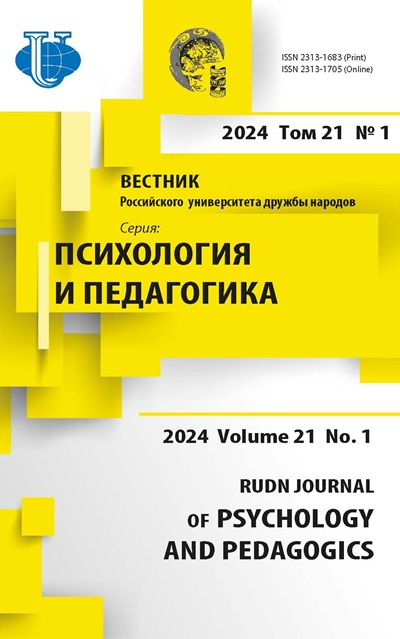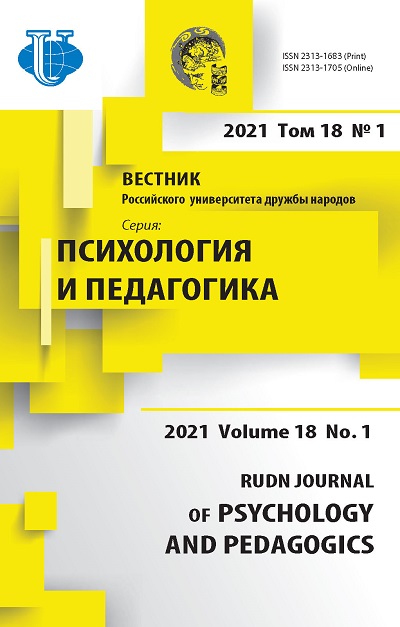Dynamics of Perception Distortions of Human Body Physical Dimensions in Virtual Reality
- Authors: Varlamov A.V.1, Yakovleva N.V.1
-
Affiliations:
- Ryazan State Medical University
- Issue: Vol 18, No 1 (2021)
- Pages: 254-270
- Section: PERSONALITY IN THE DIGITAL SPACE: NEW OPPORTUNITIES AND LIMITATIONS
- URL: https://journals.rudn.ru/psychology-pedagogics/article/view/26160
- DOI: https://doi.org/10.22363/2313-1683-2021-18-1-254-270
Cite item
Full Text
Abstract
Controlling characters in a virtual reality (VR) environment can lead to the interiorization of their body dimensions by the recipients. The possible preservation of these distortions in their psyche will indicate a high degree of psychological impact of a VR on a person and the potential danger of developing depersonalization of the recipients and their dependence on such stimulation. The study of the stability of these distortions is necessary in the context of ensuring the safety of the impact of VR environments on the human psyche. The main focus of the study is on the perception distortions of human body dimensions, as they are sensed by people immersed in a VR environment, and their dynamics depending on the number of immersions. The impact of the virtual reality environment was simulated using the Freedom Locomotion VR application. One virtual reality immersion session took 15 minutes. To obtain psychometric indicators of the subjects’ perception of their own body dimensions, the technique Measurements according to M. Feldenkrais was used. All the participants (N = 45, three experimental groups) underwent a mandatory preliminary measurement using this technique (several hours before exposure) and a final measurement (one day after the last exposure). At the same time, the results of preliminary measurements were taken as indicators of the subjects’ habitual perception of their own body dimensions and were considered in each data processing as a comparison group. Free movement in a VR environment leads to distortions in the subjects’ perception of their own body dimensions. In all the experimental groups, there was a tendency to exaggerate body dimensions immediately after immersions, which indicates the qualitative similarity of these distortions. The effect of repetitive immersion in a VR environment on the perception of body dimensions is that it increases awareness in perceiving body parts that are least active at the time of immersion. Controlling an anthropomorphic character in a VR leads to an increase in the subjective significance of the recipient’s own body perception and an increased concentration of attention on the parameters least involved in immersion. The results of the study show that an increased level of awareness in perceiving their own bodies is characteristic of the subjects who have experience of repetitive immersions in a VR environment in the guise of an anthropomorphic character. Controlling a bodily projection in a VR headset does not cause its long-term interiorization, but has a positive effect on the formation of personal corporeality.
Keywords
About the authors
Andrey V. Varlamov
Ryazan State Medical University
Author for correspondence.
Email: andrey.varlamov.62@gmail.com
specialist of the Center for Practical Psychology
9 Vysokovoltnaya St, Ryazan, 390026, Russian FederationNatalya V. Yakovleva
Ryazan State Medical University
Email: yakovleva.nata2@gmail.com
PhD in Psychology, Associate Professor, is Head of the Department of General and Special Psychology with a Course in Pedagogy
9 Vysokovoltnaya St, Ryazan, 390026, Russian FederationReferences
- Belogai, K.N., & Osipova, D.A. (2019). Adolescent Girls’ Vision of Their Body Having Various Levels of Physical Activity. The Bulletin of Irkutsk State University. Series Psychology, 27(1), 3–15. (In Russ.) https://doi.org/10.26516/2304-1226.2019.27.3
- Bergström, I., Kilteni, K., & Slater, M. (2016). First-Person Perspective Virtual Body Posture Influences Stress: A Virtual Reality Body Ownership Study. PloS One, 11(2), e0148060. https://doi.org/10.1371/journal.pone.0148060
- Ehrsson, H.H. (2007). The experimental induction of out-of-body experiences. Science, 317(5841), 1048. https://doi.org/10.1126/science.1142175
- Feldenkraiz, M. (2001). Soznavanie cherez dvizhenie: 12 prakticheskikh urokov. Moscow: Institut obshhegumanitarnyh issledovanii Publ. (In Russ.)
- Filatova, T.P. (2015). Effekt “Psikhologicheskogo pogruzheniya” v virtual'nuyu real'nost' komp'yuternoi igry, kak faktor formirovaniya komp'yuternoi igrovoi addiktsii. Aktual'nye Voprosy Sovremennoi Nauki, (44–1), 111–122 (In Russ.)
- Freeman, D., Bradley, J., Antley, A., Bourke, E., DeWeever, N., Evans, N., Černis, E., Sheaves, B., Waite, F., Dunn, G., Slater, M., & Clark, D M. (2016). Virtual reality in the treatment of persecutory delusions: randomised controlled experimental study testing how to reduce delusional conviction. The British Journal of Psychiatry: The Journal of Mental Science, 209(1), 62–67. https://doi.org/10.1192/bjp.bp.115.176438
- Freeman, D., Lister, R., Waite, F., Yu, L.M., Slater, M., Dunn, G., & Clark, D. (2019). Automated psychological therapy using virtual reality (VR) for patients with persecutory delusions: study protocol for a single-blind parallel-group randomised controlled trial (THRIVE). Trials, 20(1), 87. https://doi.org/10.1186/s13063-019-3198-6
- Guterstam, A., Larsson, D., Zeberg, H., & Ehrsson, H.H. (2019). Multisensory correlations – Not tactile expectations-determine the sense of body ownership. PloSone, 14(2), e0213265. https://doi.org/10.1371/journal.pone.0213265
- Komolov, D.A. (2016). Usage of physical measurements methods by M. Feldenkrais for the study of nonverbal cognitive component of representation of the body for children of various health groups. Uchenye zapiski universiteta imeni P.F. Lesgafta, (8), 265–267 (In Russ.)
- MKB-11. Mezhdunarodnyja klassifikatsiya boleznei 11 peresmotra. Retrieved September 12, 2020, from https://icd11.ru/nar-vyzv-patolog-vlech-k-igram/ (In Russ.)
- Nosov, N.A. (2000). Virtual'naya psikhologija. Moscow: Agraf Publ. (In Russ.)
- Polyakova, I.V. (2020). Level of development of mathematical abilities and accuracy of perception: Psychological features of interrelation. Personality in a Changing World: Health, Adaptation, Development, 8(3), 300–307. https://doi.org/10.23888/humJ20203300-307
- Preuss, N., & Ehrsson, H.H. (2019). Full-body ownership illusion elicited by visuo-vestibular integration. Journal of Experimental Psychology, 45(2), 209–223. https://doi.org/10.1037/xhp0000597
- Reger, G.M., Smolenski, D., Edwards-Stewart, A., Skopp, N.A., Rizzo, A.S., & Norr, A. (2019). Does Virtual Reality Increase Simulator Sickness During Exposure Therapy for Post-Traumatic Stress Disorder? Telemedicine Journal and E-Health, 25(9), 859–861. https://doi.org/10.1089/tmj.2018.0175
- Rizzo, A., & Shilling, R. (2017). Clinical Virtual Reality tools to advance the prevention, assessment, and treatment of PTSD. European Journal of Psychotraumatology, 8(sup5), 1414560. https://doi.org/10.1080/20008198.2017.1414560
- Rizzo, A., Parsons, T.D., Lange, B., Kenny, P., Buckwalter, J.G., Rothbaum, B., Difede, J., Frazier, J., Newman, B., Williams, J., & Reger, G. (2011). Virtual reality goes to war: A brief review of the future of military behavioral healthcare. Journal of Clinical Psychology in Medical Settings, 18(2), 176–187. https://doi.org/10.1007/s10880-011-9247-2
- Schmalzl, L., & Ehrsson, H.H. (2011). Experimental induction of a perceived “telescoped” limb using a full-body illusion. Frontiers in Human Neuroscience, 5, 34. https://doi.org/10.3389/fnhum.2011.00034
- Sevbitov, A.V., Admakin, O.I., Vasiliev, Ju.L., Skatova, E.A., & Mitin, N.E. (2015). Discussion: The features of using of the 1st and 2nd level reality simulators in the dentistry students training. Science of the Young (Eruditio Juvenium), (4), 149–143. (In Russ.)
- Slater, M. (2018). Immersion and the illusion of presence in virtual reality. British Journal of Psychology, 109(3), 431–433. https://doi.org/10.1111/bjop.12305
- Slater, M., Perez-Marcos, D., Ehrsson, H.H., & Sanchez-Vives, M.V. (2008). Towards a digital body: the virtual arm illusion. Frontiers in Human Neuroscience, 2, 6. https://doi.org/10.3389/neuro.09.006.2008
- Slater, M., Perez-Marcos, D., Ehrsson, H.H., & Sanchez-Vives, M.V. (2009). Inducing illusory ownership of a virtual body. Frontiers in Neuroscience, 3(2), 214–220. https://doi.org/10.3389/neuro.01.029.2009
- Soloviova, I.A. (2015). Bessoznatel'nyi obraz tela: Kto ty na samom dele? Retrieved September 15, 2020, from https://irsol.wordpress.com/2014/08/12/бессознательный-образ-тела-кто-ты-на-с/ (In Russ.)
- Ushakova, E.S. (2014). Internet-zavisimost' kak problema sovremennogo obshchestva. Lichnost' v Menyayushchemsya Mire: Zdorov'e, Adaptatsiya, Razvitie, (1), 44–51. Retrieved September 14, 2020, from http://humjournal.rzgmu.ru/art&id=64
- Van der Hoort, B., Reingardt, M., & Ehrsson, H.H. (2017). Body ownership promotes visual awareness. eLife, 6, e26022. https://doi.org/10.7554/eLife.26022
- Varlamov, A.V., & Yakovleva, N.V. (2019). Issledovanie dinamiki obraza tela v razlichnykh eksperimental'nykh usloviyakh virtual'noi real'nosti. Ananievskie chteniya – 2019: Psikhologiya obshchestvu, gosudarstvu, politike. Conference Proceeding (pp. 166–167). Saint Petersburg: Skifiya-print Publ. (In Russ.)
















